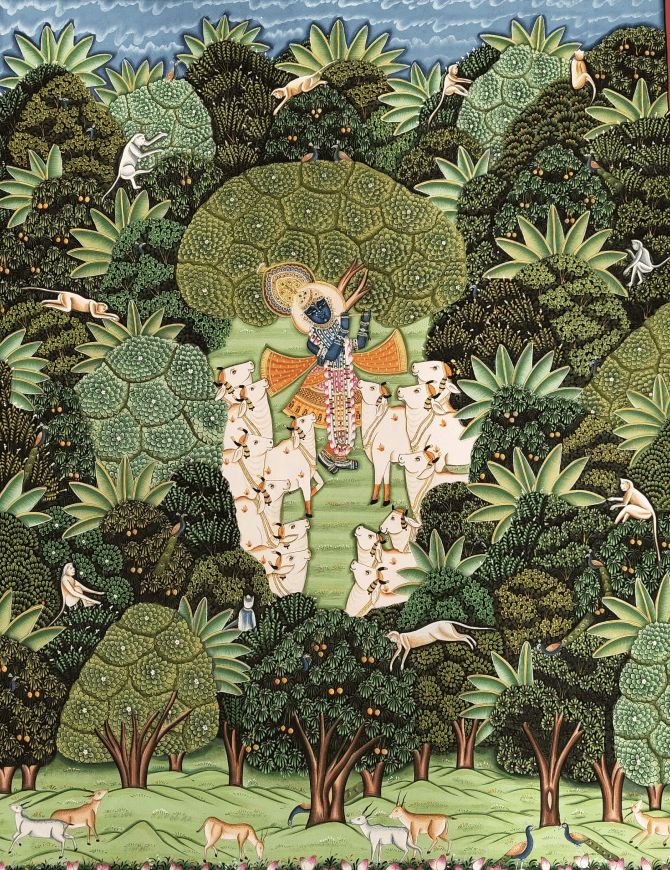Pichwai painting, a tradition dating back centuries in Nathdwara, Rajasthan, has always enjoyed a revered position in Indian culture. Typically painting stories of Lord Krishna’s life—particularly his Srinathji incarnation—Pichwai paintings adorned temple walls and told devotional stories through gorgeous, detailed visuals.
But the intricate paintings are enjoying a renaissance today. Contemporary Pichwai paintings are infusing new life into this divine tradition, combining classic motifs with modern aesthetics to capture the eye of the contemporary art enthusiast without diminishing their cultural significance.
The Roots of Pichwai Painting
Originating from the Sanskrit terms pich (back) and wai (hanging), Pichwai painting was born more than 400 years ago. It was originally developed as a backdrop behind the idol of Srinathji, depicting various moods, seasons, and festivals like Janmashtami, Sharad Purnima, Annakut, and Holi. These original artworks were labor-intensive, painted by hand with great detail on cloth using natural dyes, gold leaf, and minute detailing.
The subjects were typically associated with cows, lotus, peacocks, gopis, and the iconic figure of Srinathji holding Mount Govardhan aloft. It would take months for an artist to finish one work, and each brushstroke would be for spiritual benefits.

The Evolution into Modern Pichwai
Over the past few decades, young artists and designers have rediscovered the art of Pichwai for modern environments. Contemporary Pichwai paintings carry the divine symbols and motifs of old artwork but reinterpret them through lines minimalist in style, palettes of pale color, geometric forms, and stylized images. These new forms are not limited to temples alone but are now seen in upmarket homes, city studios, galleries, and even virtual canvases.
Art is an evolving mechanism in daily activities, which is among some of the major forces behind this change. Unlike the earlier Pichwais which were religious objects, the modern one serves the purposes of designed objects and religious items. This trend is also a reflection of the general tendency, when the traditional crafts are complemented and altered in a way that would fit the global target audience of shape and interior.
Techniques That Blend Old and New
Although contemporary Pichwai painters still find inspiration in original themes and compositions, they freely experiment with media and form. From silk scrolls hand-painted to wall murals, printed canvases, and framed paintings, the forms are changing. Traditional materials such as natural dyes and handmade paper are still used by some artists, but others use acrylics, inks, and digital software.
Additionally, the size of the paintings has changed. The traditional Pichwai paintings were huge and temple-sized, but modern ones are of manageable size to be fitted in apartments, offices, and urban settlements. Such sizes make the art form more current, and make it more affordable to modern audiences.
The Rise of Modern Collectors
There is increasing appreciation for contemporary Pichwai paintings by collectors and art lovers, not only in India but also in the world. The combination of classical narration with contemporary aesthetic sensibilities has found acceptance among a broad spectrum of people—right from young urban dwellers to aficionados of Indian heritage. The emergence of curation-based shows, art fairs, and social media has additionally put a focus on the skill behind this genre of fusion.
This renewed interest is also playing a vital role in sustaining the livelihoods of traditional artisans, many of whom are now collaborating with contemporary designers to create limited-edition pieces and bespoke art.
Celebrating Tradition Through Art
We at Aavyaan bring the tradition in life with our beautiful and modern Pichwai paintings. Our crafts are a traditional and contemporary adaptation, as we unite the elements of traditional artistry with the image of modernity. Our art work is imbued with story, with beauty and with piety.
Frequently Asked Questions
1. What is the difference between traditional and modern Pichwai paintings?
Traditional Pichwai paintings follow classic styles and themes, while modern Pichwai paintings reinterpret these elements with contemporary designs and colors.
2. Are your Pichwai paintings handmade?
Yes, all our Pichwai artworks are handcrafted by skilled artisans with deep respect for tradition.
3. Can I customize a Pichwai painting for my space?
Absolutely. We do custom-made Pichwai art as per your choice, location, and motifs
4. Do you extend shipping to other countries?
Yes, we deliver our artworks across the world with safe packaging to deliver safety.


